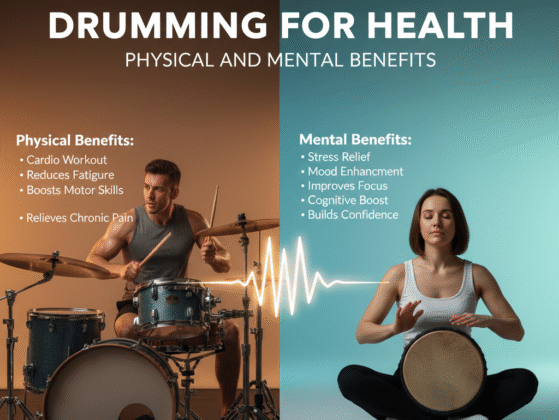Best Vocal Exercises for Singers | Enhance Your Voice and Range
Singing is a skill that combines natural talent with refined technique. While some people are born with a good voice, almost everyone can improve their singing ability with the right practice and exercises. One common question among aspiring singers is: “Do vocal exercises improve singing?” The answer is a resounding yes. This blog will explore the benefits of vocal exercises, different types of exercises, and how they can transform your singing voice.
Understanding Vocal Exercises
Vocal exercises are specific routines designed to warm up the voice, improve vocal range, strengthen the vocal cords, and enhance overall vocal health. Just like athletes need to warm up their muscles before a workout, singers need to prepare their vocal cords to prevent strain and injury.
The Science Behind Vocal Exercises
When you sing, your vocal cords (or vocal folds) vibrate at high speeds. Vocal exercises help to:
- Strengthen the vocal muscles: Regular practice can build muscle memory and strength, allowing for better control and endurance.
- Increase flexibility and range: Exercises can stretch and loosen the vocal cords, making it easier to hit higher or lower notes.
- Improve breathing technique: Proper breathing is crucial for singing, and exercises often focus on enhancing breath control and lung capacity.
- Enhance resonance and tone quality: Training can help in producing a richer, fuller sound by optimizing the use of the vocal tract.

Benefits of Vocal Exercises
1. Improved Vocal Range
Vocal exercises, such as scales and arpeggios, increase the range of comfortable notes, enabling singers to hit high notes effortlessly.
2. Better Pitch Accuracy
Exercises like lip trills and interval training refine pitch control, helping singers stay in tune consistently.
3. Enhanced Vocal Strength and Endurance
Regular vocal exercises strengthen vocal cords and muscles, boosting endurance for longer performances.
4. Increased Breath Control
Techniques like diaphragmatic breathing exercises improve breath management, enabling smoother phrases and sustained notes.
5. Improved Tone and Resonance
Exercises focusing on resonance and tone production, like humming and vowel modification, enhance voice quality for a fuller sound.
6. Prevention of Vocal Strain and Injury
Vocal warm-ups and cool-downs before and after singing reduce the risk of strain or injury, crucial for maintaining vocal health, especially for professionals.

Types of Vocal Exercises
Warm-Up Exercises
- Lip Trills: Vibrating lips together to relax vocal cords and enhance breath control.
- Humming: Gentle warm-up focusing on resonance by gliding up and down the scale.
- Sirens: Mimicking a siren’s sound to stretch vocal cords and increase flexibility.
Breath Control Exercises
- Diaphragmatic Breathing: Strengthening the diaphragm and improving breath support.
- Hissing Exercise: Controlling airflow by exhaling through teeth, sustaining the hiss.
Pitch Accuracy Exercises
- Interval Training: Practicing various intervals to refine pitch accuracy.
- Pitch Matching: Matching notes played on a piano or pitch pipe to develop ear training.
Range Expansion Exercises
- Scales and Arpeggios: Singing scales and chord arpeggios to stretch vocal cords and increase range.
- Octave Jumps: Challenging vocal range and control by jumping between octaves.
Tone and Resonance Exercises
- Vowel Modification: Exploring resonance with different vowel sounds in a simple melody.
- Nasal Resonance: Utilizing nasal resonance effectively by singing with and without nasal obstruction.

Incorporating Vocal Exercises into Your Routine
Consistency is key when it comes to vocal exercises. Here are some tips for incorporating them into your routine:
- Set Aside Time Daily
Aim to practice vocal exercises for at least 15-30 minutes each day. This ensures regular engagement with your vocal cords without overexerting them. - Warm-Up First
Always start with warm-up exercises to prepare your voice for more demanding activities. - Mix It Up
Incorporate a variety of exercises to target different aspects of your voice. This keeps your practice interesting and well-rounded. - Listen to Your Body
Pay attention to any signs of strain or discomfort. If something feels wrong, stop and rest. Pushing through pain can lead to vocal damage. - Record Yourself
Recording your practice sessions can help you track progress and identify areas for improvement. - Seek Professional Guidance
Working with a vocal coach can provide personalized feedback and structured guidance tailored to your voice and goals.

Real-Life Success Stories
Many famous singers attribute their success to consistent vocal exercise routines. For example, Beyoncé is known for her rigorous vocal warm-ups and exercises that keep her voice in top shape for demanding performances. Similarly, opera singers like Renée Fleming follow strict vocal regimens to maintain their powerful and flexible voices.
Conclusion
Vocal exercises are essential for singers, offering a range of benefits from improving health and quality to enhancing confidence and versatility. Whether you’re starting out or a seasoned pro, consistent practice leads to significant improvements. Understanding the science behind these exercises and committing to a routine unlocks your full potential, ensuring a lifetime of healthy, expressive singing. With countless success stories worldwide, the answer to whether vocal exercises improve singing is a resounding yes. Master singing with our expert Instructors from the comforts of your home.
For more information and exciting resources about learning music, visit our website at The Mystic Keys. For more music content and exciting offers follow us on








